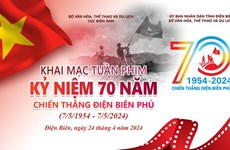Bana try to preserve oldest village
Lying alongside the poetic Dak Bla River is Kon Ko Tu, the oldest
village in Kon Tum city in the Central Highlands province of Kon Tum.
Lying alongside the poetic Dak Bla River is Kon Ko Tu, the oldest
village in Kon Tum city in the Central Highlands province of Kon Tum.
Located in the Dak Ro Wa Commune of the Bana ethnic minorities, the village is considered the key point of gong culture in the Central Highlands, with dozens of houses on stilts featuring specific characteristics of the Bana architecture, where many residential houses surround a communal house.
Living through and surviving the changing fortunes of history and the impact of socio-economic development, Kon Ko Tu village has managed to retain its specific cultural features. Every day, male villagers go to their fields in the mountains and hunt for deer while female villagers weave fabrics and make baskets.
The village organises its own festival with gong in the Rong house, considered as the community or communal house.
Kon Ko Tu now has more than 20 houses on stilts which were built based on traditional Bana architecture. Each house is rectangular in shape, about 10m in length and built on 12 wooden pillars. Three or four generations of a family live in a single house, each of which serves as a strong attachment of the community and a source of pride for the Bana.
The village has more than 100 households with a population of about 600.
A Xep, the village patriarch, revealed that when the village was first set up, it had very few people. So the patriarch named the village Kon Ko Tu, meaning desolate village.
He then chose a place to build the Rong (long communal) house while residents chose the locations of their own houses around the collective house.
At that time, the forests yielded large quantities of durable and valuable timber, so people were able to harvest enough wood for their needs.
The Bana people in Kon Tum province have a charming traditional culture. Besides gong, they have various kinds of traditional musical instruments, including the t'rung, which is similar to the xylophone, and the ting gling and tingning, which are stringed musical instruments. They also have numerous smooth and passionate folk songs.
The village celebrates annual festivals, including the harvest festival and buffalo-sacrifying festival.
Traditional dishes that are attractive to tourists include bamboo tube rice. Bamboo tubes are used as a cooking pot, and after the rice is cooked, the tube is broken and the contents are removed.
Other dishes include chicken baked with salt and chilli and fried bamboo shoots. A traditional drink offered at festivals is ruou can, wine which one drinks from a jar using pipes. All these dishes and the drink convey the flavour that is uniquely Bana.
Huynh Duc Tien, Director of the Kon Tum Tourism Company Ltd., said most tourists to the province, especially foreigners, have chosen to visit the village first before going to other tourist sites. Villagers are known to be quite hospitable and experienced in pampering prissy visitors.
A Tao, the village chief, said a good number of visitors have asked villagers to let them stay overnight at the Rong house to study the Bana people's culture.
At the long communal house, tourists can enjoy the sound of the gong and dance around a flickering fire. They can also go by dug-out canoe to the Dak Bla River that meanders along the Kong Muk Mountain.
Recently, the State built a network consisting of traffic roads, irrigation systems and schools in the village, which has since been converted into an ecological and cultural site, so the residents' living standards have improved, Tao said.
The village lads are trained to work as tour guides while women weave brocades to sell to tourists.
Mari Helene Hauze, a French visitor, said she was impressed with the peaceful beauty of the village forests and the hospitality of villagers.
To develop tourism in the village, local authorities should implement policies to preserve and exploit its strong points. Ecological tourism should be developed to help tourists experience the forests' natural beauty.
Nguyen Nhu Quynh, a tourist from Ho Chi Minh City, was impressed with old villagers legends and was interested in practising the weaving of baskets and brocades with Bana women.
Phan Thanh Nam, Chairman of Dak Ro Wa commune, said a lot of traditional cultural features risked being lost to oblivion as the number of houses on stilts have been gradually reduced.
Rich people have been asked to purchase houses made of durable and valuable timber, and the weaving of baskets and fabrics has become commercialised, with women focusing more on quantity rather than quality.
Villagers still practise slash-and-burn cultivation, so forest resources were eventually exhausted, Nam added.
Kon Tum province has improved a campaign to raise residents' awareness of the need to protect the forests and their culture, including traditional festivals.
Groups of fabric weavers have received financial support from local authorities, and houses have been built to display their products.-VNA
Located in the Dak Ro Wa Commune of the Bana ethnic minorities, the village is considered the key point of gong culture in the Central Highlands, with dozens of houses on stilts featuring specific characteristics of the Bana architecture, where many residential houses surround a communal house.
Living through and surviving the changing fortunes of history and the impact of socio-economic development, Kon Ko Tu village has managed to retain its specific cultural features. Every day, male villagers go to their fields in the mountains and hunt for deer while female villagers weave fabrics and make baskets.
The village organises its own festival with gong in the Rong house, considered as the community or communal house.
Kon Ko Tu now has more than 20 houses on stilts which were built based on traditional Bana architecture. Each house is rectangular in shape, about 10m in length and built on 12 wooden pillars. Three or four generations of a family live in a single house, each of which serves as a strong attachment of the community and a source of pride for the Bana.
The village has more than 100 households with a population of about 600.
A Xep, the village patriarch, revealed that when the village was first set up, it had very few people. So the patriarch named the village Kon Ko Tu, meaning desolate village.
He then chose a place to build the Rong (long communal) house while residents chose the locations of their own houses around the collective house.
At that time, the forests yielded large quantities of durable and valuable timber, so people were able to harvest enough wood for their needs.
The Bana people in Kon Tum province have a charming traditional culture. Besides gong, they have various kinds of traditional musical instruments, including the t'rung, which is similar to the xylophone, and the ting gling and tingning, which are stringed musical instruments. They also have numerous smooth and passionate folk songs.
The village celebrates annual festivals, including the harvest festival and buffalo-sacrifying festival.
Traditional dishes that are attractive to tourists include bamboo tube rice. Bamboo tubes are used as a cooking pot, and after the rice is cooked, the tube is broken and the contents are removed.
Other dishes include chicken baked with salt and chilli and fried bamboo shoots. A traditional drink offered at festivals is ruou can, wine which one drinks from a jar using pipes. All these dishes and the drink convey the flavour that is uniquely Bana.
Huynh Duc Tien, Director of the Kon Tum Tourism Company Ltd., said most tourists to the province, especially foreigners, have chosen to visit the village first before going to other tourist sites. Villagers are known to be quite hospitable and experienced in pampering prissy visitors.
A Tao, the village chief, said a good number of visitors have asked villagers to let them stay overnight at the Rong house to study the Bana people's culture.
At the long communal house, tourists can enjoy the sound of the gong and dance around a flickering fire. They can also go by dug-out canoe to the Dak Bla River that meanders along the Kong Muk Mountain.
Recently, the State built a network consisting of traffic roads, irrigation systems and schools in the village, which has since been converted into an ecological and cultural site, so the residents' living standards have improved, Tao said.
The village lads are trained to work as tour guides while women weave brocades to sell to tourists.
Mari Helene Hauze, a French visitor, said she was impressed with the peaceful beauty of the village forests and the hospitality of villagers.
To develop tourism in the village, local authorities should implement policies to preserve and exploit its strong points. Ecological tourism should be developed to help tourists experience the forests' natural beauty.
Nguyen Nhu Quynh, a tourist from Ho Chi Minh City, was impressed with old villagers legends and was interested in practising the weaving of baskets and brocades with Bana women.
Phan Thanh Nam, Chairman of Dak Ro Wa commune, said a lot of traditional cultural features risked being lost to oblivion as the number of houses on stilts have been gradually reduced.
Rich people have been asked to purchase houses made of durable and valuable timber, and the weaving of baskets and fabrics has become commercialised, with women focusing more on quantity rather than quality.
Villagers still practise slash-and-burn cultivation, so forest resources were eventually exhausted, Nam added.
Kon Tum province has improved a campaign to raise residents' awareness of the need to protect the forests and their culture, including traditional festivals.
Groups of fabric weavers have received financial support from local authorities, and houses have been built to display their products.-VNA













